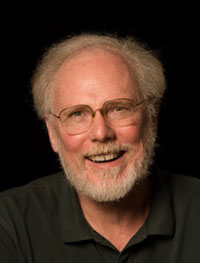

 Skip to navigation
Skip to navigation
Site Primary Navigation:
- About SDSC
- Services
- Support
- Research & Development
- Education & Training
- News & Events
Search The Site:

Published 04/03/2008
For Immediate Release

Professor J. Andrew McCammon Photo: Paul Fetters, 2005 |
Media Contacts:
Jan Zverina
SDSC Communications
858 534-5111 or
jzverina@sdsc.edu
Warren R. Froelich
SDSC Communications
858 822-3622 or
froelich@sdsc.edu
J. Andrew McCammon, the Joseph E. Mayer Chair of Theoretical Chemistry at the University of California, San Diego, is the recipient of the American Chemical Society's 2008 National Award for Computers in Chemical and Pharmaceutical Research. He will receive the prestigious ACS award at the society's national meeting in New Orleans on April 8th.
McCammon, a chemistry and biochemistry professor in UCSD's Division of Physical Sciences, is also a Distinguished Professor of Pharmacology at UCSD and an Investigator of the Howard Hughes Medical Institute. As a leader in computer-aided drug discovery programs, McCammon joined UC San Diego in 1995, and has been using the computational resources at UCSD's San Diego Supercomputer Center to further his research on molecule interactions. He has been a fellow of SDSC since 1995.
Professor McCammon is credited with inventing theoretical methods for accurately predicting and interpreting molecular recognition, the rates of reactions, and other properties of chemical systems. These methods are playing an ever-increasing role in the design of new drugs.
The American Chemical Society, the world's largest scientific society, is a non-profit organization chartered by the U.S. Congress providing access to chemistry-related research through its databases, peer-reviewed journals and scientific conferences.
Following is an article by Elizabeth Wilson, Senior Editor for Chemical & Engineering News, on Professor McCammon and the 2008 National Award for Computers in Chemical and Pharmaceutical Research. C&EN is the weekly publication of the American Chemical Society.
ACS Award for Computers in Chemical and Pharmaceutical Research
By Elizabeth Wilson
Senior Editor, Chemical & Engineering News
The computational description of a biological molecule, frozen in a single snapshot, is complicated enough, but to describe its flexibility and interactions with other molecules is a task that until recently could tax the biggest supercomputers.
A couple of decades ago, the idea that computers could predict the nanosecond-scale dynamics of proteins was almost unfathomable. But now, chemists have sophisticated computational methods that make it possible to design groundbreaking drugs, thanks in large part to the work of J. Andrew McCammon, Joseph E. Mayer Chair of Theoretical Chemistry at the University of California, San Diego.
"In the 1970s, it took a great deal of courage to begin the study of big biological problems," notes Peter Wolynes, Francis H. C. Crick Chair in the Physical Sciences and professor of chemistry, biochemistry, and physics at UC San Diego. McCammon "has brought intellectual order to the study of the dynamics of biological molecules," Wolynes says.
Numerous drug designers and pharmaceutical companies have turned to McCammon's strategies. Last October, Merck announced Food & Drug Administration approval of its new anti-HIV agent Raltegravir, developed with McCammon's methods. The drug thwarts an essential integrase enzyme that helps the virus's genetic material invade immune cells.
McCammon has made major inroads into the problem of modeling protein flexibility. Protein reactions were first envisioned as the insertion of a rigid key into a rigid lock. Then chemists designed software that accounted for ligand flexibility. But protein motion is far more computationally intensive.
McCammon also pioneered a concept known as "computational alchemy," by which computers calculate the changes in free energy when one ligand is substituted for another. This helps determine what ligands might bind most strongly to a protein.
McCammon was born in 1947 in Lafayette, Ind. He received an A.B. in chemistry, mathematics, and physics from Pomona College in 1969. He then went to Harvard University, where he received an A.M. in physics in 1970 and a Ph.D. in chemical physics in 1976.
After spending two more years at Harvard as a research fellow in chemistry, McCammon went to the University of Houston. There he was an assistant professor of chemistry from 1978 to 1981 and M. D. Anderson Chair in Chemistry from 1981 to 1994. He was also the founding director of the university's Institute for Molecular Design from 1987 to 1994 and professor of biochemical and biophysical sciences from 1989 to 1994. In 1995, McCammon went to UC San Diego.
McCammon has been a Howard Hughes Medical Institute investigator since 2000 and a fellow of the San Diego Supercomputer Center since 1995.
He has been a fellow of the American Association for the Advancement of Science since 1997. He received the UC San Diego School of Pharmacy & Pharmaceutical Sciences' Faculty Excellence Award for Teaching in 2003. He was elected an American Academy of Arts & Sciences fellow in 2006.
San Diego Supercomputer Center (SDSC) -
www.sdsc.edu
UC San Diego Skaggs School of Pharmacy & Pharmaceutical Sciences
pharmacy.ucsd.edu
American Chemical Society -
www.acs.org